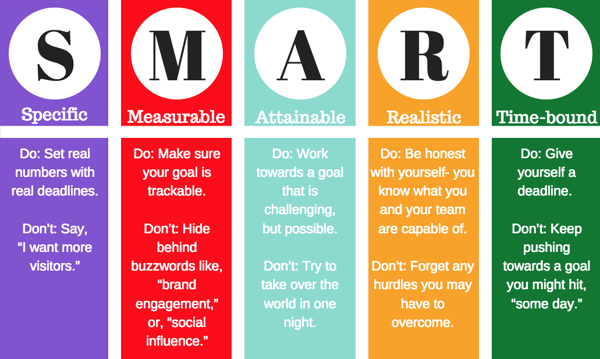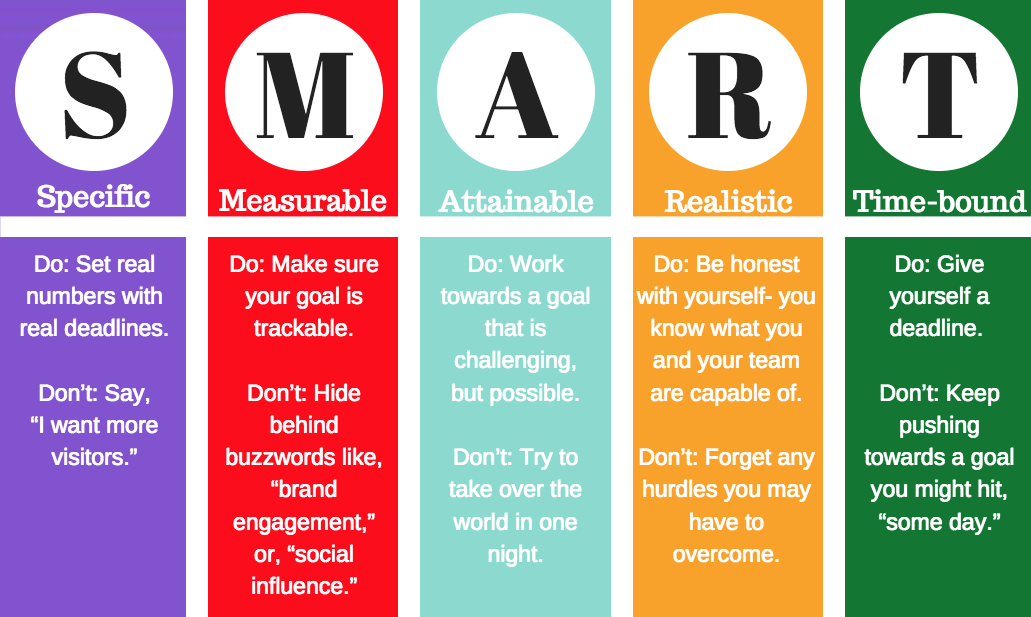Embark on a productivity journey with SMART Goals – a concept commonly attributed to Peter Drucker's Management by Objectives. As you may have guessed, SMART is an acronym. Over the years, it has taken on many different meanings. Traditionally, a SMART Goal is Specific, Measurable, Attainable, Realistic, and Time-bound.
Other definitions include:
- S - simple, sensible, significant
- M - meaningful, motivating
- A - agreed
- R - reasonable, resourced, result-based
- T - time-based, time-limited, time/cost-limited, time-sensitive
Fun fact: A few authors have even gone as far as to add two more letters, making it SMARTER;
“E” being Evaluated, and “R” being Reviewed.
Click here to learn how AI can assist in your SMART Goal-setting journey!
Think of a SMART Goal as your GPS that will guide you through these checkpoints on your journey to success. Setting one for yourself allows you to clarify your ideas, focus your efforts, and allocate your time in a way that promises the most return and the highest chance of achievement. Keep reading to discover how the simplicity and power of SMART Goals can help you on your path to optimal productivity.

Specific - Limit your goals to a single area so they are not too vague. It might help to start by considering the six W questions:
- Who - Who is involved?
- What - What do you want to accomplish?
- When - When is your timeframe?
- Where - Where is your location?
- Why - Why are you setting this goal, and how will accomplishing it benefit you?
- Which - Which requirements and constraints do you need to consider?
For example, if you want to increase sales, a more specific way to phrase your goal would be, "I will research and implement new techniques for turning prospects into customers." Or perhaps you wish your remote team was better at communicating. A specific goal to address this issue would be, "I will streamline our systems and introduce the cloud-based team messaging platform Slack to make communication easier and more effective in my workplace."
Measurable - Establish the criteria for measuring your progress while you work towards your goal. Measuring progress is integral as it ensures accountability and provides a clear roadmap. Also, this SMART step will help you:
- Stay on Track: Defining measurable parameters helps you set timelines, and regular check-ins against these benchmarks act as navigational markers.
- Make Timely Adjustments: Identify deviations early on so you can make necessary course corrections and minimize the risk of straying too far from the intended path.
- Identify Effective Strategies: Tracking measurable outcomes reveals what efforts yield the best results and provides invaluable insight so you can ensure that time and energy are optimally invested.
Sticking with the original examples, set a numeric goal when aiming to increase revenue, and then log your sales to help you measure and stay on track. If you want to improve communication in your remote workplace, you should set an expectation with your team of how often they should send messages in your newly introduced software, Slack. After that, monitor the platform's channels to gauge how well your goal is being met.
Attainable - When you identify your goal and determine how you will achieve it, you see how attainable it is and how much effort it will require. Assessing attainability involves:
- Comprehensive Planning: Break down your goal into manageable steps. This enhances clarity and reveals potential challenges that can be proactively addressed.
- Workload Consideration: Pursuing this goal shouldn't compromise your ability to follow through on current commitments or maintain overall project efficiency and quality.
- Time Dedication: Realistic time management is crucial for preventing overextension and ensuring that each task receives the attention required for successful completion.
For example, tripling your sales next year may not be attainable. But if you have enough experience and a solid strategy, you could double them. When working toward improved communication, don't expect each team member to discuss everything that happens during the day with everyone. However, you can ask them to share their to-do lists each morning and check in when they've completed an assigned task.

Realistic - To be realistic, your goal should represent an objective everyone involved is able and willing to work toward. Here's why realism matters:
- Achieve Harmony: Ensure that your goal aligns with both your organizational objectives and individual capacities. A realistic goal strikes the right balance between ambition and practicality.
- Avoid Hurdles: Aiming high is commendable. Realism is not about lowering the bar but about setting it at a height that challenges without creating unnecessary issues.
- Assess Bandwidth: Realistic goals consider the resources, skills, and time available, fostering an environment where all contributors can actively and effectively work toward success.
In the examples above, it may be attainable to double your sales next year. However, if that will require all hands on deck and a scary amount of overtime, you must further lower that number to make your goal both attainable and realistic. If you're working toward improved communication with Slack messages, asking every employee to read every message might be attainable but not realistic. People should discuss daily task completion with others working on the same project instead of expecting the whole company to be involved in every conversation.
Time-bound - As mentioned in a few previous SMART steps, time is a crucial component of goal achievement. Here are a couple of timely tips:
- Execute with Precision: Being time-bound means not just setting deadlines but crafting a well-defined timeline that acts as a catalyst for focused action. Defining clear time boundaries imparts urgency and provides a roadmap for progress checks
- Learn from the Past: If you've conquered similar tasks within a specific period before, doing so again is feasible since you've already proven your capabilities. Previous successes become the benchmarks against which you measure and refine your current goals.
When you set the time frame of one year in the example goal of increasing sales, you also set a pace for researching and implementing new conversion techniques. It puts pressure on accomplishing these tasks at the beginning of the year. This way the results of your hard work will be apparent come Q4. The same is true of increasing communication. Decide when you will introduce Slack to your team, an adjustment period for everyone to get familiar with the platform, and a date to review how much the new systems and software have been helping.
SMART Goals provide the clarity and focus required to get the most out of your efforts. They also omit the possibility of overlooking major or minor details that will help or hinder your efforts toward achieving your goals. SMART Goals are a great way of mentally preparing for what is ahead. With more knowledge of what has to be done, you will be focused and aware of times when your attention should be aimed elsewhere.
This blog was originally part of the How to Monitor Social Media in 10 Minutes a Day eBook download and was updated in December 2023.








